Which brings us to Grace Hartigan. If raw imagery equals form for the naive artist, then that is where Hartigan has gone. Because she recognized the sexism implicit to New York painting at the time, Grace Hartigan rose to prominence 20 years ago under the name George. In so doing, she drew attention to the male focus implicit to Abstract Expressionism. Hartigan’s work then derived from that part of Matisse in which thin color struggled with the analytical standards set by Matisse’s awareness of Cubism. Hartigan’s text of the ’50s was Matisse’s Bathers by a River of 1916. By degrees, vestigial figuration was driven out from her battered and flayed surfaces, and that expulsion led to her finest painting, although a painting visibly in the debt of Hans Hofmann. Hofmann too had traveled this terrain—Matisse plus Cubism yields (unexpectedly) color abstraction. It was he who established this trajectory as a model for American painting almost a generation prior to Hartigan’s retrodding of this path.
Assuming that art answers strategies, Hartigan’s next phase ought to have been a field painting in the proscriptive manner of a Greenberg votary. This is exactly what did not happen due to the artist’s refusal to admit that art is capable of such a reduction to strategies. I dislike Hartigan’s new pictures, but my absence of sympathy with them is not to the point, for I admire the artist’s refusal to succumb to a painting that merely reflects a suite of critical ploys.
Thus, instead of Machiavellian painting, Hartigan gives us something more accessible and known, painting as the subtle address of a thick brush that establishes crude and automatic contours that are filled in by rather unclear color. Hartigan crowds her wall-scaled painting with an expressive imagery cued by folk art, animal images, Mayan codices, Greek geometric vase painting, Picasso, so-called primitive patterns and, of course, the direct examination of nature.
I find this painting trite and impressive. To dwell on the latter, what is impressive is the clear sense that the artist projects of her rediscovery of painting. It is this acute sense that carries the exhibition far above the bankrupt intentions of color field painting today—not so much by what is painted as by what is rejected. In this, Hartigan maintains her admirable adversary stance vis-a-vis contemporary New York pieties; in so doing, she is George anew.
—Robert Pincus-Witten
